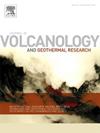哥伦比亚加雷拉斯火山全新世火成岩密度流的新证据
IF 2.3
3区 地球科学
Q2 GEOSCIENCES, MULTIDISCIPLINARY
Journal of Volcanology and Geothermal Research
Pub Date : 2024-10-04
DOI:10.1016/j.jvolgeores.2024.108203
引用次数: 0
摘要
加雷拉斯火山群(Galeras Volcanic Complex,GVC)是一座复合火山,位于哥伦比亚南部的中部和西部山脊之间。它被认为是哥伦比亚最活跃的火山之一,具有典型的火山喷发特征。根据地层和地质年代的不同,复合火山被分为不同的阶段。最近的一个阶段被称为加雷拉斯阶段,被认为始于约 4500 年前。本研究介绍了对大峡谷西北部 El Barranco 河谷沿岸出露的沉积物进行地层学和地质年代分析的新结果,通过分析,我们确定了最近阶段(即 Galeras 阶段)中较新和较旧的沉积物。我们通过浮石碎片的分布、地层、地质年代、成分和粒度以及泡状和微纹理对这些沉积物进行了分析。我们发现了三个以前未报道过的沉积物,因此山谷中共有八个火成岩密度流(PDC)沉积物,它们不和谐地覆盖在大峡谷前一阶段(即杰诺伊阶段;150-40 ka)的安山质熔岩流之上。这些沉积物被命名为 U1 至 U8 单元,其中 U1、U2 和 U8 单元代表了 Galeras 火山喷发史上未曾记录的事件。U1单元(8303 ± 97 和 8284.5 ± 90.5 大卡 BP)、U2单元(7667 ± 78 大卡 BP)、U3单元(5082 ± 198、5096.5 ± 226.5、5801.5 ± 481.5 和 5966 ± 235 大卡 BP)和 U6 单元(2215.5 ± 101.5 和 2033 ± 91 大卡 BP)被解释为由与次火山喷发柱坍塌有关的富含浮石流产生的 PDC 形成,而 U5 单元(3201.5±129大卡BP)、U7(1066.5±109.5和944.5±115.4大卡BP)和U8(390.5±80.5大卡BP)单元被解释为由与火山口内穹隆的破坏和火神期喷发柱的崩塌有关的块状流和火山灰流产生的PDC形成。U4(4625 ± 181 cal BP)与 "爆炸 "型事件有关,是由粘性岩浆气体产生的超压造成的。根据上述记录,我们可以认为加雷拉斯火山的喷发历史始于全新世初期(公元前 8300 年),而不是之前确定的公元前 4500 年,这就产生了危险影响。拉佛罗里达镇的 U8 单元以及附近有记录的沉积物表明,该地区的居民可能会受到 PDC 的危害。本文章由计算机程序翻译,如有差异,请以英文原文为准。
New evidence of Holocene pyroclastic density currents at Galeras volcano, Colombia
The Galeras Volcanic Complex (GVC) is a composite volcano located between the Central and Western cordilleras in southern Colombia. It is considered one of the most active volcanoes in Colombia, with typically Vulcanian eruptions. The complex has been divided into different stages based on stratigraphic and geochronological differences. The most recent one is called the Galeras stage and is considered to have started ca. 4500 years. This study presents the results of new stratigraphic and geochronological analysis of the deposits that outcrop along the El Barranco river valley, NW of the GVC, which allowed us to identify newer and older deposits within the most recent stage (i.e., the Galeras stage). The deposits were analyzed via distribution, stratigraphy, geochronology, componentry and granulometry, as well as vesicularity and microtexture of the pumice fragments. We identified three previously unreported deposits, which results in a total of eight pyroclastic density current (PDC) deposits in the valley, which discordantly overlie andesitic lava flows of the previous stage (i.e., Genoy stage; 150–40 ka) of the GVC. They were named from Unit U1 to Unit U8, with units U1, U2 and U8 representing events not previously recorded in the eruptive history of Galeras volcano. Units U1 (8303 ± 97 and 8284.5 ± 90.5 cal BP), U2 (7667 ± 78 cal BP), U3 (5082 ± 198, 5096.5 ± 226.5, 5801.5 ± 481.5 and 5966 ± 235 cal BP) and U6 (2215.5 ± 101.5 and 2033 ± 91 cal BP) are interpreted as formed by PDCs generated by pumice-rich flows linked to the collapse of Subplinian eruptive columns, while units U5 (3201.5 ± 129 cal BP), U7 (1066.5 ± 109.5 and 944.5 ± 115.4 cal BP) and U8 (390.5 ± 80.5 cal BP) are interpreted as formed by PDCs generated by block and ash flows linked to the destruction of intracrater domes and the collapse of Vulcanian eruptive columns. U4 (4625 ± 181 cal BP) is associated with a “blast” type event, caused by the overpressure exerted by the gases of a viscous magma. The above mentioned record allows us to propose that the eruptive history of Galeras volcano began at the beginning of the Holocene (∼8300 years BP), and not 4500 BP, as previously established, which has hazard implications. Unit U8 in the town of La Florida as well as the nearby recorded deposits, indicates a probable PDC hazard for this population.
求助全文
通过发布文献求助,成功后即可免费获取论文全文。
去求助
来源期刊
CiteScore
5.90
自引率
13.80%
发文量
183
审稿时长
19.7 weeks
期刊介绍:
An international research journal with focus on volcanic and geothermal processes and their impact on the environment and society.
Submission of papers covering the following aspects of volcanology and geothermal research are encouraged:
(1) Geological aspects of volcanic systems: volcano stratigraphy, structure and tectonic influence; eruptive history; evolution of volcanic landforms; eruption style and progress; dispersal patterns of lava and ash; analysis of real-time eruption observations.
(2) Geochemical and petrological aspects of volcanic rocks: magma genesis and evolution; crystallization; volatile compositions, solubility, and degassing; volcanic petrography and textural analysis.
(3) Hydrology, geochemistry and measurement of volcanic and hydrothermal fluids: volcanic gas emissions; fumaroles and springs; crater lakes; hydrothermal mineralization.
(4) Geophysical aspects of volcanic systems: physical properties of volcanic rocks and magmas; heat flow studies; volcano seismology, geodesy and remote sensing.
(5) Computational modeling and experimental simulation of magmatic and hydrothermal processes: eruption dynamics; magma transport and storage; plume dynamics and ash dispersal; lava flow dynamics; hydrothermal fluid flow; thermodynamics of aqueous fluids and melts.
(6) Volcano hazard and risk research: hazard zonation methodology, development of forecasting tools; assessment techniques for vulnerability and impact.

 求助内容:
求助内容: 应助结果提醒方式:
应助结果提醒方式:


